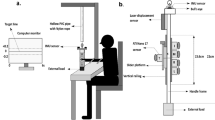Abstract
Previous research has identified that prehension is composed of a reach and a grasp component and that the position and size of the object can independently affect each. However, no effects on prior to contact prehension kinematics have been reported for manipulations in object mass. We felt that this ‘lack of a finding’ was surprising, as a more accurate grip position on heavier objects would prevent slippage and rotation when lifting the object. Therefore, we hypothesized that increased object mass would effect the grasp component movement kinematics prior to contact in preparation for a stable final grip placement on the object. We report two experiments in which participants reached, grasped and lifted objects of various size and mass, and their movement kinematics were recorded using a motion tracking system. The results showed that the mass of the object significantly influenced prior-to-contact grasp kinematics. Both studies showed that the heavy compared to light objects caused increased peak grasp aperture, a final finger and thumb placement on the object that more closely passed through the object centre of mass, increased lift delay and reduced peak lift velocity. The data are discussed in terms of how object mass influences the reach, grasp and lift components of prehensile movement.

Similar content being viewed by others
Notes
Note that for each object size, there was a light and heavy object. Therefore, the manipulation of mass did not co-vary with size. However, the manipulation of object size did co-vary with mass so that objects of increased size were also heavier. Because of this, any reliable effects of object size might result from size or mass differences.
While participants used all of their digits to make the grasp, we were only able to record the kinematic position of the index finger and thumb due to the limitations of using a two-camera motion tracking system.
Circular statistics were not used as it was expected that there would never be an instance of a participant grasping the object at 5–355° where the use of circular statistics would be critical.
References
Arbib MA, Iberall T, Lyons D (1985) Coordinated control programs for control of the hands. Exp Brain Res Suppl 10:111–129
Bootsma RJ, Marteniuk RG, MacKenzie CL, Zaal FT (1994) The speed-accuracy trade-off in manual prehension: effects of movement amplitude, object size and object width on kinematic characteristics. Exp Brain Res 98:535–541
Brouwer A, Georgiou I, Glover S, Castiello U (2006) Adjusting reach to lift movements to sudden visible changes in target’s weight. Exp Brain Res (in press)
Flanagan JR, Wing AM, Allison S, Spenceley A (1995) Effects of surface texture on weight perception when lifting objects with a precision grip. Percept Psychophys 57:282–290
Glover S (2004) Separate visual representations in the planning and control of action. Behav Brain Sci 27:3–24
Goodale MA, Milner AD, Jakobson LS, Carey DP (1991) A neurological dissociation between perceiving objects and grasping them. Nature 349:154–156
Jeannerod M (1981). Intersegmental coordination during reaching at natural visual objects. In: J Long A Baddley (eds) Attention and performance IX. Hillsdale, Erlbaum, pp 153–168
Jeannerod M (1984) The timing of natural prehension. J Motor Behav 16:235–254
Johansson RS, Westling G (1988) Coordinated isometric muscle commands adequately and erroneously programmed for the weight during lifting task with precision grip. Exp Brain Res 71:59–71
Lederman SJ, Wing AM (2003) Perceptual judgement, grasp point selection and object symmetry. Exp Brain Res 152:156–165
Marteniuk RG, Leavitt JL, MacKenzie CL, Athenes S (1990) Functional relationships between grasp and transport components in a prehension task. Hum Movem Sci 9:149–176
Miall RC, Wolpert DM (1996) Forward models for physiological motor control. Neural Netw 9:1265–1279
Milner AD, Goodale MA (1995) The visual brain in action. Oxford University Press, Oxford
Napier JR (1956) The prehensile movements of the human hand. J Bone Joint Surg 4:902
Smeets JB, Brenner E (1999) A new view on grasping. Motor Control 3:237–271
Weir PL, MacKenzie CL, Marteniuk RG, Cargoe SL, Frazer MB (1991) The effects of object weight on the kinematics of prehension. J Motor Behav 23:192–204
Wing AM, Turton A, Fraser C (1986) Grasp size and accuracy of approach in reaching. J Motor Behav 18:245–260
Acknowledgments
Thanks to Professor Glyn Humphreys for the loan of the motion tracking equipment, without which these data would not be possible. Thanks also to the participants that volunteered their time to the study. The School of Sport and Exercise Sciences, University of Birmingham funded the project.
Author information
Authors and Affiliations
Corresponding author
Rights and permissions
About this article
Cite this article
Eastough, D., Edwards, M.G. Movement kinematics in prehension are affected by grasping objects of different mass. Exp Brain Res 176, 193–198 (2007). https://doi.org/10.1007/s00221-006-0749-3
Received:
Accepted:
Published:
Issue Date:
DOI: https://doi.org/10.1007/s00221-006-0749-3




